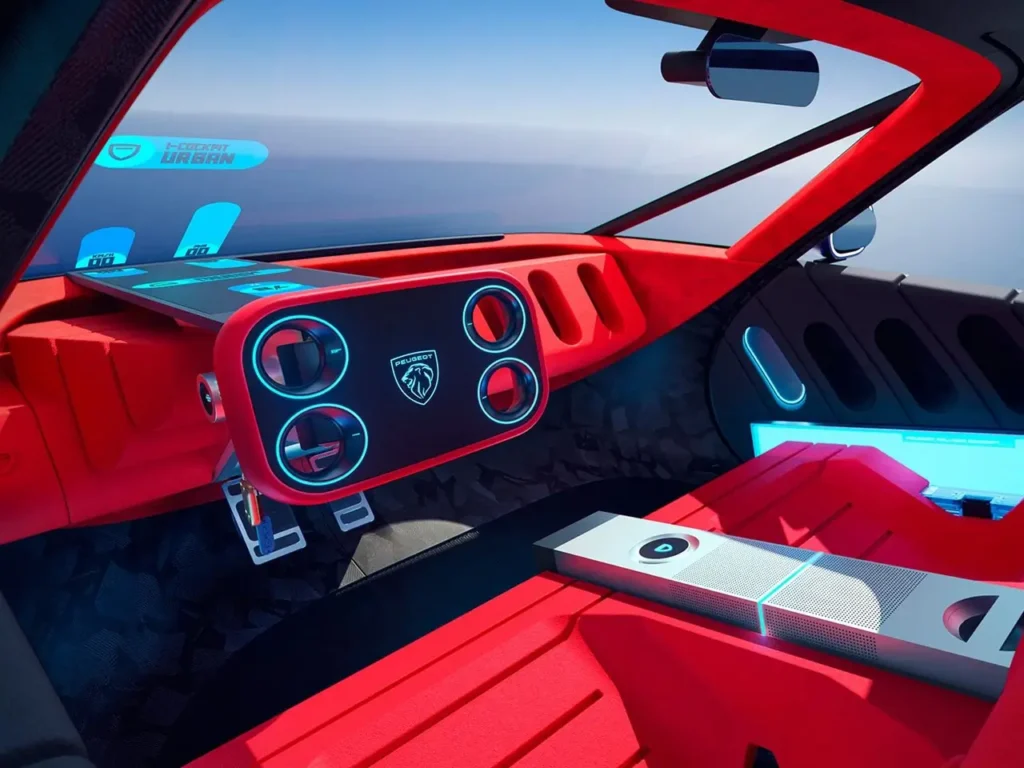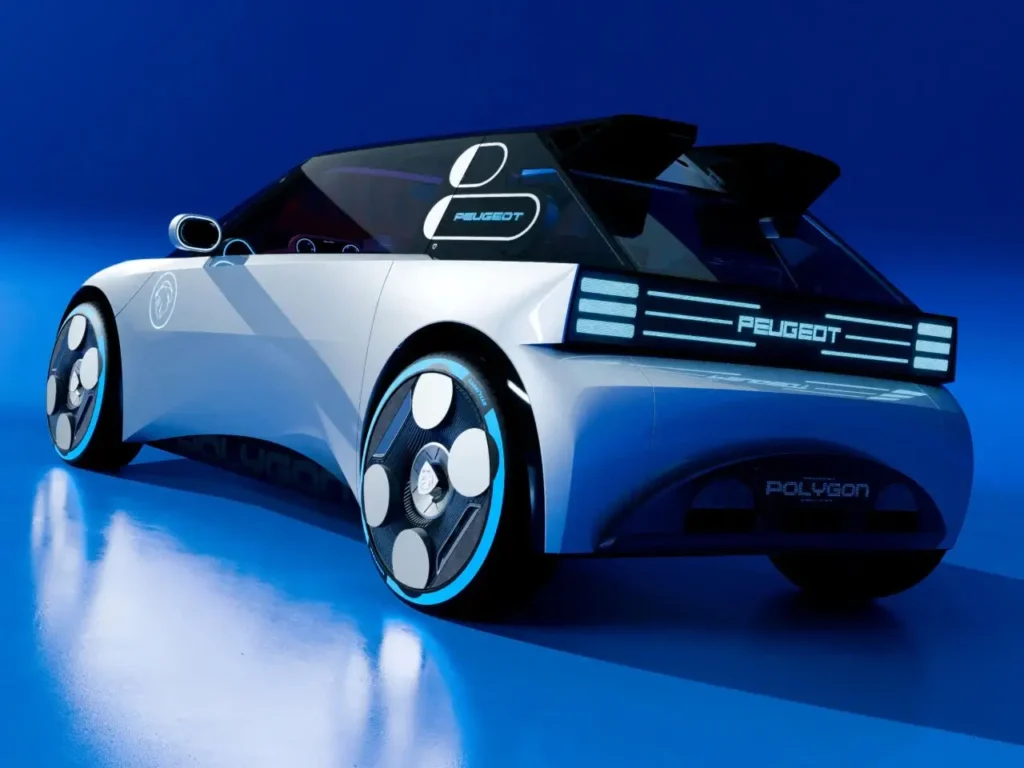Peugeot has spent the last decade reshaping its identity through design, shifting from its once-utilitarian hatchbacks to a portfolio known for its bold light signatures, sculpted forms, and confident French futurism. The brand’s modern catalog—stretching from the 208 to the 508, from the 3008 to the e-3008—reveals a company with an unusually cohesive aesthetic philosophy in the European mass-market space. But with the Polygon Concept, Peugeot signals a deeper shift, one that stretches beyond styling language into architectural experimentation, material innovation, and interface reinvention.
Positioned as a sub-4-meter electric supermini, the Polygon Concept is more than a concept tease. It is a compressed manifesto, a conceptual bridge between present-day production logic and the experimental optimism of future Peugeot models. It signals where the next 208 may evolve, but it also proposes a larger question: how should a compact EV be shaped when constraints of combustion packaging no longer apply?
The Polygon approaches this not by exaggerating scale or by stretching out its proportions, but by intensifying the compactness that has defined Peugeot’s success in the B-segment. The result is a small car with a big presence, a vehicle that balances approachability with sophistication in ways that feel distinctly Parisian.
supermini
When most manufacturers reinterpret compact cars for the electric age, they tend to do so by smoothing forms, removing creases, and projecting aerodynamics as the primary design narrative. Peugeot does the opposite here. The Polygon Concept is defined by fractal geometry—angular, assertive, almost architectural in its presence.
The sub-4-meter length grounds it in the practicality of a true supermini, but the crisp volumes and faceted bodylines introduce a sculptural intensity rarely seen at this scale. Instead of the soft, anthropomorphic forms of the past, the Polygon reflects a sharper digital-era persona. It feels cut from a single piece of alloy, like an industrial design object scaled up to automotive size.
This is not merely styling for styling’s sake. Peugeot expresses that such geometry serves a dual purpose: improved aerodynamic channeling through angular surfacing, and visual mass redistribution to make a small footprint feel balanced and confident. The body sides taper toward a taut beltline, while exaggerated wheel arches integrate into a clean diamond-shaped plan view. Unlike many concepts that inflate proportions artificially, the Polygon remains grounded in the physicality of an actual production chassis.
It is Peugeot’s most mature exploration of geometric design since the e-Legend, but whereas that car celebrated retro-futurism, the Polygon is strictly forward-facing.
identity
Lighting is now the true signature of modern automotive identity, and Peugeot has arguably one of the strongest motifs in the mainstream market: the three-claw arrangement. For the Polygon Concept, the design team radically reinterprets this hallmark—not vertically as on current models, but horizontally, in razor-thin micro-LED stripes.
At the front, the three-claw light bars stretch across a flush surface, giving the car a razor-edged expression reminiscent of contemporary consumer technology rather than traditional automotive fascia. There is no grille, no protruding intake, no sculptural nose. Instead, the front reads as a clean plane punctuated by digital light. The horizontal shift also makes the face appear wider and more planted, a welcome visual trick for a vehicle of this size.
The rear takes the concept further. The three stripes span nearly the entire width of the tail, integrated into a translucent light blade that seems to float above the rear bumper. It recalls high-end European EVs but adapts the idea with Peugeot’s unique tri-band signature. For night visibility, the stripes perform adaptive animations—sweeping, dimming, pulsing—yet Peugeot notes these animations are grounded in functional cues, not merely ornamental theater.
This lighting language will not appear identically on the next 208, but the horizontal logic and micro-LED execution clearly preview where the brand is heading.
arch
Perhaps the most striking feature of the Polygon Concept is its choice to abandon the practical five-door configuration of everyday superminis for large butterfly doors that open upward and outward. They transform the vehicle’s entry sequence into a theatrical gesture—something more akin to a sports coupe than a commuter hatch.
Peugeot acknowledges that such doors are not intended for mass-market production. Rather, they serve to emphasize the structural clarity and interior openness of the design. By removing the B-pillar visually and mechanically, the Polygon becomes a small space that feels surprisingly expansive. This is an architectural trick long favored by concept car designers: open the cabin to demonstrate interior volume, modular seating, and packaging possibilities that might otherwise go unnoticed behind conventional doors.
In the real world, the next 208 will almost certainly retain traditional access points. But the Polygon’s butterfly doors offer clues to Peugeot’s thinking: a lighter, more open cabin; slimmer structural beams; and inventive glazing patterns that improve visibility even as body panels sharpen.
tactility
Peugeot’s recent interiors—such as those in the 308 and 408—have impressed critics with their blend of textile warmth, precise switchgear, and a distinctive i-Cockpit layout. The Polygon Concept takes these ideas into a more experimental realm, where materials are chosen not just for luxury narratives but for sustainability and clarity of purpose.
Inside the Polygon, surfaces are intentionally matte, textured, and tactile. There is a conspicuous absence of high-gloss plastics, which designers argue age poorly and feel inconsistent with Peugeot’s evolving brand ethos. Instead, the cabin favors recycled composites, lightweight bio-resins, technical fabrics, and anodized metals. Nothing is meant to feel overly soft or overly ornamental. The interior design aligns with a more functional aesthetic—one that relies on honesty of materials.
Peugeot claims that the Polygon’s cockpit explores a direction of “techno-minimalism,” where every component serves a clear purpose and every surface communicates structural logic. The dashboard’s horizontal beam is exposed like a piece of architecture, and the seat shells are left partially visible, showcasing their composite weave. This approach aligns with growing consumer interest in transparency—both in manufacturing practices and in product honesty.
phil
Peugeot’s signature i-Cockpit—a small steering wheel paired with a high-mounted digital display—has become one of the brand’s most recognizable innovations. For the Polygon Concept, the i-Cockpit becomes more spatial, more intuitive, and more integrated into the architecture.
The digital instrument cluster is reimagined as a floating holographic panel that projects depth rather than surface brightness. Instead of a traditional rectangular screen, the projection widens horizontally, mirroring the new lighting motif on the exterior. This creates continuity between interior and exterior cues, refining Peugeot’s design identity into a cohesive twenty-first-century expression.
The steering wheel remains compact but takes on a polygonal form inspired by the car’s exterior geometry. Its upper section flattens dramatically, improving forward visibility while hinting at gaming-inspired ergonomics. Peugeot acknowledges that this form is experimental, but the eventual production steering wheel in future models may adopt aspects of this architecture.
Central controls shift to a modular touch surface located between the seats. Instead of a large, tablet-like infotainment screen dominating the dash, the Polygon disperses information through smaller precision interfaces. The result is a cockpit that feels more like a curated workspace and less like a mobile entertainment system.
package
An electric vehicle’s most challenging design constraint is often its battery footprint. Peugeot approaches this by optimizing the Polygon’s underfloor pack and treating the car’s compact size as a strength rather than a limitation.
To compensate for its short length, the Polygon uses vertical packaging logic: thinner seats, elevated hip-points, and a lowered floor center section. This creates a cabin that feels more open without sacrificing structural integrity. The decision to use butterfly doors also helps to eliminate visual clutter from pillars, reinforcing the sense of openness.
The Polygon also highlights its ability to become a social micro-space. The rear bench folds into a semi-lounge configuration, acknowledging the growing trend among EV users to use their vehicles as compact personal hubs for charging, working, or relaxing. Peugeot does not claim this configuration will reach production, but its exploration demonstrates the brand’s awareness of changing user behaviors in urban mobility.
perform
While Peugeot has not released full technical specifications for the Polygon Concept, the brand emphasizes that its goal is to demonstrate what a fun, expressive, compact EV can feel like—not merely how it can function. The emphasis is on lightness rather than brute power. In a world where many compact EVs exceed 1,800 kilograms, Peugeot hints at a more disciplined approach: smaller battery, smarter efficiency, and more agility.
The Polygon likely uses a low-to-mid capacity battery intended for fast urban charging, and it is almost certain that the next-generation 208 will inherit much of this logic. By focusing on balance rather than range inflation, Peugeot aligns itself with a broader European movement toward lighter, more responsible EVs that prioritize real-world usability over spec-sheet posturing.
For enthusiasts, Peugeot suggests that electric torque delivery will make the Polygon playful, especially given its short wheelbase and low center of gravity. Although performance is not the centerpiece of the concept, the brand clearly understands that character matters as much as efficiency—even in the smallest segment.
design
The Polygon Concept is not an isolated object. It represents the convergence of Peugeot’s design, engineering, and brand identity work over the past decade. Its purpose is twofold: to preview the core themes of the next-gen 208 and to communicate the brand’s broader vision for accessible electric mobility.
In this sense, the Polygon is a design manifesto. It declares that compact cars need not be modest, minimal, or subdued. They can be sculptural. They can be expressive. They can hold the same gravitas as larger vehicles while maintaining an ecological footprint aligned with modern European priorities.
If the e-Legend was Peugeot’s declaration of emotional heritage, the Polygon is its declaration of forward momentum.
impression
Peugeot’s Polygon Concept arrives at a moment when the automotive industry is reassessing what the entry-level EV should be. Should it be a simplified tool? A downsized version of a larger vehicle? Or should it be a canvas for exploring new ideas in shape, proportion, interior architecture, and digital experience?
Peugeot answers confidently with the Polygon: small does not mean simple, and compact does not mean compromise. At under four meters, the car is proof that the next generation of electric superminis can carry the same design ambition as flagship EVs. By pushing lighting signatures, geometric surfacing, material intelligence, and cockpit reinvention, the Polygon asserts itself as a crucial piece of Peugeot’s future.
The next 208 will not adopt every radical element seen here. But the Polygon concept reveals the creative direction guiding Peugeot’s coming decade—one that embraces electric architecture not as a constraint, but as an opportunity for expressive, intelligent, and sustainable design.
It is a small car, but it carries a large vision.
No comments yet.












